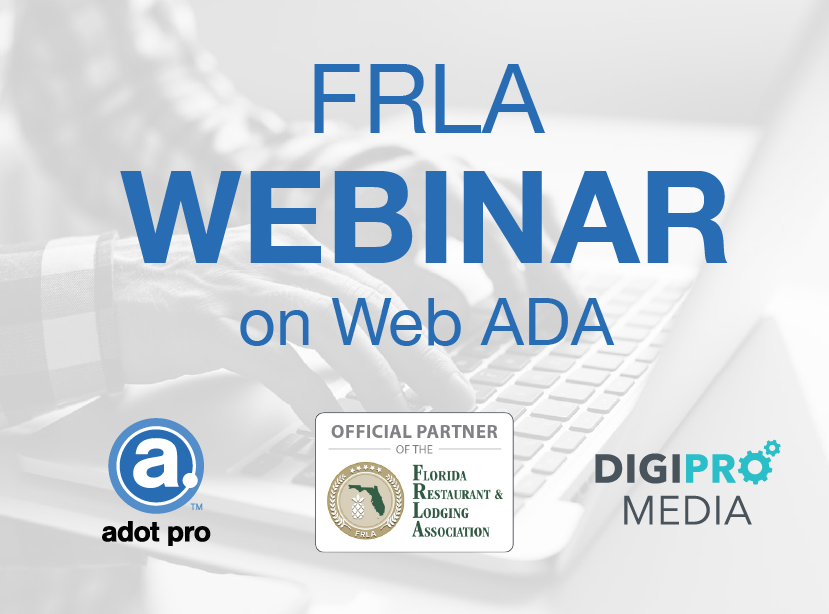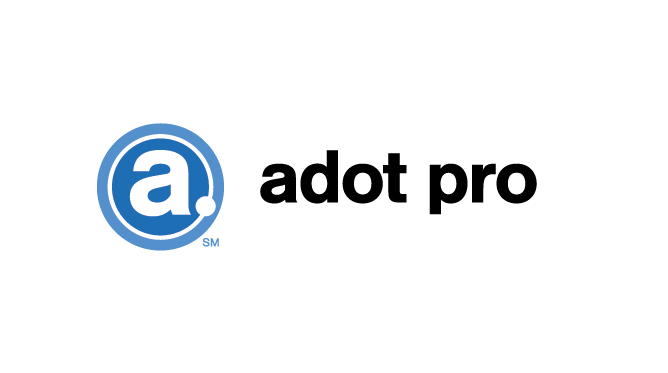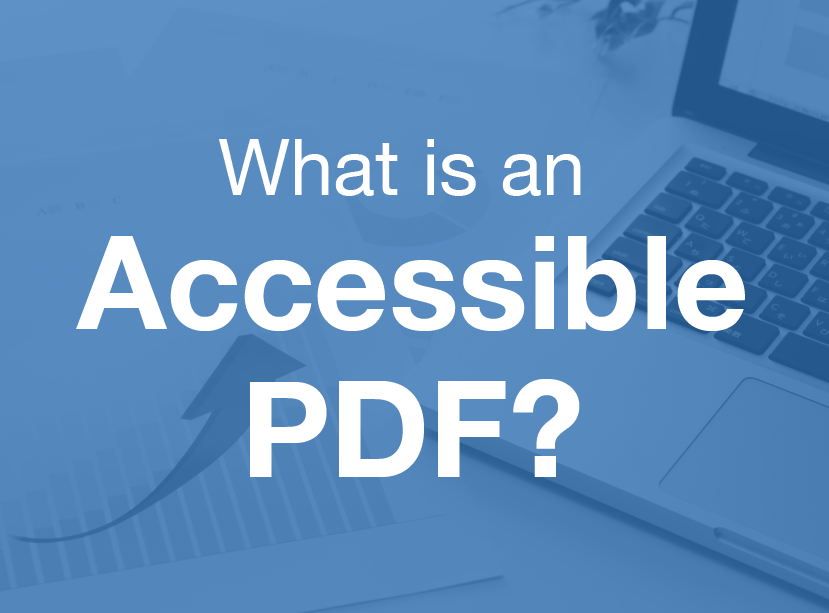FRLA Webinar on Web ADA March 21
- April 2, 2018
- / Adot Labs
- / learningcenter

Transcript:
Slide appears with FRLA logo, adot logo and DigiPro media logo
Sally: Yeah, well welcome everybody, thanks for joining us. We’re excited to have John and the DigiPro team back for round two of some webinars. This is such a hot topic in the industry right now. We are really excited to be able to partner with you guys and extend your expertise to our membership. You guys did a great webinar about a month ago now and for those of you who have not seen that one, it is up on the FRLA website so definitely check it out after this one and with that I’m gunna turn it over to you John to introduce your team and get started.
John: okay perfect, so I appreciate that, so Sally I’m gunna mute your line real quick and just to make sure everybody knows, this is an interactive webinar. We want you to ask questions and we want to be able to help you. It’s a conversation that is a little bit different than what you’re used to at the end of the day. DigiPro, we’re a media company, we build websites, we help companies build their online brands. We got into the accessibility space probably about four or five years ago. One of our board members was a military veteran and was blind and we were building out a not-for-profit site that he was a part of and when doing that there was a big thing to consider because he couldn’t see the website so we had to make sure the website was accessible for home and I think this was four or five years ago now. So we got into the world of accessibility when it comes to building out websites, and we’ll get into a little bit of that in the background but what I want to do today is make sure you understand the difference. DigiPro Media is our media company, we are based in Pensacola Florida. We are super excited to be partnered with the FRLA and help with this and we have a plug-in, which is another product that is called adot pro and adot I’ll explain a little bit later in the presentation. Adot Pro exists to help people build quick, easy solutions for accessibility and helps you get off the radar for lawsuits that so many FRLA members have been a part of. So I’m gunna recap, the first probably eight to ten slides are a recap of my first webinar that we did on this but I think it’s important that we bring some of this stuff back to light because some of you, I’m looking at the attendee list here and some of you I don’t recognize, which is great. So I’m gunna make sure I can recap on what we’ve talked about last time and then kind of dive in and then eventually I’m gunna introduce Stephanie. So first question, again this interactive, you gotta help me with this
Slide with text reading “When was ADA written into law in the USA?
John: in the chat box the ADA trivia question number one, When was ADA written into law in the United States? Just give me your best guess, alright we can see some answers coming in and just so you know I can see if you’re not responding so I can you out. So don’t sit back and don’t do anything ha-ha. Okay, so we’ve got a couple responses coming in, yep, looking good. Alright, so I’ve got several ranges here, I’ve got as far back as 1970 and I have as recent as late nineties so the correct answer here is actually 1990 and so in 1990
Slide with text reading “American with Disability Act (ADA) enacted in 1990, the ADA prohibits places of public accommodation, like restaurants and hotels, from discriminating against individuals with disabilities. The ADA did not specifically include websites as a place of public accommodation because the interne was still in its infancy when the ADA was adopted. The federal government has not offered official guidelines on how the ADA applies to websites and this inaction has created a lot uncertainty in the federal court system.”
John: the ADA was enacted and it basically prohibits places of accommodation, like restaurants and hotels, from discriminating against individuals with disabilities. However, when this law was written in 1990, the federal government did not have any idea how this was going to affect what is considered property, which is your website and the federal government today was not offered official guidelines on how the ADA applies to websites. So this inaction on their part is causing a lot of uncertainty on trying to figure out how this thing works. So something I want you to wrap your head around though is
Slide appears with text reading “ADA Trivia, How did you access the internet in 1990?”
John: how did you access the internet in 1990, so really think about that, go back, rewind a little bit and think about what did you do on the internet in 1990? This is something that is a very thought provoking question and yep, someone said an AOL cd. AOL was in the mid-nineties. I had one person that said nothing, yep a lot of people did not interact with it. So what I did is I went back and did a little trivia of my own, a little research and
Slides appears with text reading “ADA Trivia, The first web browser was invented in 1990 by Sir Tim-Berners-Lee. Berners-Lee is the director of the World Wide Web Consortium (W3C), which oversees the web’s continued development and is also the founder of the World Wide Web Foundation. His browser was called Worldwide Web and later renamed Nexus.
John: this is actually a screen of the first public web browser, it was invented in 1990. It was called the world wide web which was later called Nexus, but this is what it looked like. It’s very different from the internet that we see today and I only bring that up because while a law was written that long ago, it’s still affecting people today. If you wanna learn more about it I put that URL there in the bottom. This organization, W3C is actually one of the organization’s that helps leads the charge in accessibility and making sure the web has certain guidelines around it.
Slide appears with text reading “Web Standard for ADA, Web Content Accessibility Guidelines, WCAG Version 2.0, Level AA, and image of an article stating DOJ nixes pending ADA rulemakings, including website access rules”
John: So, in talking about those guidelines, if the federal government doesn’t give us those guidelines what do we use? Because we were all getting pretty excited because in late 2017 there was a lot of ADA laws and rules that were on the table but everything got wiped off. So this is one of the websites, its link is in the bottom of this slide, go check it out. It kind of goes through in a little more depth they nixed all the ADA rulemaking so we’re still in the same boat which is , it’s still a little bit of the wild west when it comes to how this stuff works. Under what we build and how we build accessible sites, we follow WCAG 2.0 Level AA guidelines, so I know that’s a mouthful but what that stands for Web Content Accessibility Guidelines. So that is a standard, it’s like 400 guidelines that helps navigate us to make sure the web is accessible.
Slide appears with text reading “ADA trivia, Has your business or a friends business been sued under ADA law?”
John: I’m just curious here, last ADA trivia question and then we’re going to get into some more content. Has your business or a friends business been sued under ADA law? I’m not just talking about web ADA, but just ADA in general. Okay we’ve got a couple yes’s here. Okay one person said yeah, my shopping cart on our website. So, if you’ve been engaged with an ADA lawsuit, if you don’t know what to look for it can sometimes be hard to turn around and fight them and it can be expensive and what we’re going to talk about today, a little but more in detail now is how ADA law relates to your website and I’m really gunna try to make this simple and easy to understand because what it comes down to is you have your place of business and then you have a website. This website is considered a property of your business. This website contains information like menus, contact information, specials, different locations that you might have, hours of operation just to give you an idea. On the far right here, you have the ADA impaired individual and that can be a multitude of different things and you have your non-impaired. Now under ADA law, you cannot discriminate, the information has to be accessible to both parties. So simply put, your website must provide equal access to all the users who are visiting and if you’re not building it properly form the start and you’re not putting the right things on your website to clarify how your site’s being done you can get hit with a lawsuit. Again, this goes back to the department of justice is not giving us that clarity of what is or what isn’t so we are going back and using these WCAG guidelines and we’ve been successful. Now if you’re avoiding, or if your website was not built under these guidelines, you’re not using accessibility statements, what happens is you end up getting lawsuits.
Slide appears with text reading “A real ADA web lawsuit, what it says” and an image of someone holding a piece of paper that says lawsuit
John: And so we get these on a weekly basis, just this week I’ve seen two more from the state of Florida alone that have been sued under a Title 3 ADA law.
Slide appears with text reading “A real ADA lawsuit, what it says” and multiple images of a real ADA lawsuit
John: So what I want to do is show you what is says so you get one of these summons you have an idea of what they’re looking for. Now I will say that there’s no one standard for every single lawsuit we’ve seen. There’s a couple different variations that come through. Let me show one that we recently, and we did talk about this on the last webinar
Slides appears with an image of the introduction of a lawsuit
John: so in the introduction of this lawsuit it basically says that this person was a blind and visually impaired consumer and that basically the website did not comply with accessibility laws.
Slide appears with image of section fourteen of a web ADA lawsuit
John: Furthermore, this is section fourteen, what it goes through here is it talks about the screen reader software is the primary method in which a blind person may independently use the internet. The guidelines that the international web standards are WCAG 2.0 AA, this is what we follow, this is what we keep seeing getting named over and over and over again so it’s the resource that we use to build out sites and to build out our products to make sure that it’s accessible to this screen reader software.
Slide appears with image of sections nineteen and twenty of a web ADA lawsuit
John: If you wanted to wrap it up, this section right here, section twenty, went through the access barriers of the website. So let’s talk about that for a quick second, accessing barriers. One, the text equivalent for every non-text element is not provided. So anything that is a non-text element a screen reader has to have a description of what that element is. If it’s left blank, a screen reader can’t use it. Going down here, the web pages do not have titles that describe topic or purpose. So if you build out a standard site and let’s say you used Wordpress or GoDaddy By Night, if you don’t go through and describe the things on there, you’re giving barriers. The big one here, we’ll talk more about this later, there is no accessibility statement regarding a company’s policy to assist disabled users found on the website. This is a big one because accessibility statements when written properly, let me keep in mind we are not attorney’s we are web builders so any accessibility statement you get have it vetted by your attorney, that’s my disclosure there. A good written accessibility statement has been able to show to get people out of the summons because if you have an accessibility statement, you’re giving the person the ability to get in touch with you or interact with your business and you’re not creating barriers for them, then it does show a case study there that you’re then able to get in touch with the person, they can get in touch with you and you can work through the barrier that they were having.
Slide appears with text reading “Screen Reader Software for Windows and Mac and two images of the landing pages for JAWS and VoiceOver”
John: So I know we talked a little bit about screen readers and I want to mention the two biggest ones that are being used on the internet right now. This left version is called JAWS and that JAWS software is very popular on windows-based products. Over to the right is the apple-based which is called VoiceOver, so like it has it on your macs, it has it on your apple devices. We’re actually gunna look at, we’re gunna do a demo today of JAWS and I’m gunna share my screen with one of my partners here at DigiPro, her name is Stephanie. Stephanie is legally blind and she’s actually gunna use the JAWS software and we tested this out yesterday and it worked pretty good, sometimes the audio is in and out but I think it will give people a good idea of how people interact with the internet using a screen reader.
Slide appears with text reading “List of Brands that have been sued under Title 3 ADA Law and logos of NBA, Bank of America, Netflix, Winn Dixie, H&R Block, Target, The Miami Grill, Island Water Sports and Oasis Hotel”
John: Now these are the brands that have been sued under Title 3 ADA law for their websites. I bring this up just because it’s a lot bigger situation than some people give it credit for because if you’re not looking for it sometimes you might not notice it. But at the top, I’m sure everyone is familiar with the brands at the very top here, potentially all the brands there at the middle. On the bottom though, these are just local businesses in Florida that we’ve been in touch with that have all been sued under ADA law. Miami Grill, they were actually sued three times before we got in touch with them. I’m gunna show you a version of their site that we helped them set up also.
Slide appears with text reading “Questions so far?”
John: So I’ve been talking here for a couple minutes, I just want to pause for a quick second and just ask are there any general questions so far about some of the topics we’ve talked about? I know some of this stuff is confusing or kind of outside the box if you’ve been looked at it. Okay so right now I’m not seeing any general questions come up, keep them at the back of your head. At any time you have one you can just go ahead and pop it in the chat box, I can always go back and reference it later, it gives me a nice little rolodex of the questions coming in. Okay with that being said what I wanna do now is I wanna introduce Stephanie.
Slides appears with text reading “Stephanie Bollinger, College Graduate w/ 4.0 GPA, Ambassador and Board Member for the Independence for the Blind, Award-winning Ball Room Dancer and QA Tester for DigiPro Media with image of Stephanie dancing”
John: Stephanie is one of our QA testers and let me give you a little background on Stephanie. She’s a college graduate, she graduated college with a 4.0. She’s an ambassador and board member for Independence for the Blind, that’s how we were able to get into contact with her. She’s an award winning ballroom dancer, this is a picture of her, you can actually see a video of her on YouTube ballroom dancing. She’s outstanding, so what I’m gunna do is she’s gunna come on and she’s gunna use her screen reader software and go through what is called a links list and a links list what it does is it actually provides the user the ability to read the website. So let’s go here, let me get Stephanie’s. Okay give me a second let me turn over controls to Stephanie’s computer and I have Savannah with her, Savannah’s gunna be helping us get everything set up. Okay so, Savannah, Stef, y’all should be good to go let me know if. Alright perfect I can see your screen. Stef go ahead and say hi to everybody, go ahead and introduce yourself.
Screen appears of McGuire’s website
Stephanie: Good morning everybody, I am Stephanie Bollinger. I have been completely blind for almost seven years and I’ve been working here at DigiPro for almost two months now as the accessibility tester. So today I am going to show a website of ours, a client of ours who we are currently rebuilding them a new site to make it accessible. So I’m going to show you their old site. We have received permission from them to show you the inaccessibility of their old site and then I’m gunna show you one of the websites for another client of ours who we have made completely accessible just to show you the differences and the difficulties I face on a regular basis.
JAWS software reads “graphic to top”
Stephanie: Okay so the website I’m gunna show you to begin with, I’m gunna take you through the McGuire’s site and their menu and their photo gallery. In order to move around the internet, when I’m on a website what I have to use is what I call my links list. My links list helps me to get through every single link, different pages on a website. I’m gunna pull that up and show you what that looks like.
JAWS software reading “links list dialogue McGuire’s, events, shop, menu”
Stephanie: Okay so that is what my links list looks like, now I’m gunna go ahead and go to the page.
JAWS reading “heading level two lunch menu:
Stephanie: Okay now that I’m on the menu page I’m gunna scroll down so that you can hear what I’m hearing and as I go through I’ll stop my JAWS software so that I can explain a couple things to you and the issues I’m facing.
JAWS reading “both locations, daily from 11 am to 4 pm”
Stephanie: okay so far it’s looking like it’s gunna be okay because it’s telling me which locations and the hours
JAWS reading “link graphic image”
Stephanie: and now as you can see I am facing a major because it seems to me like there actually is no listed menu, nothing telling me what food items they have, no descriptions of those food items, no prices. But it looks to me, as far as hearing wise, that I am reading an image. So when it says graphic lunch menu or graphic dinner menu, first I’m thinking that would be a picture of the menu. However, I do know from working here that is a pdf document, which is another major obstacle because I’m not able to access these pdf documents. So there’s no way to know if I would go to this restaurant or not because I do not know what kind of food they serve, I do not know their prices or anything of that nature so it’s a major issue for someone like myself who has any kind of disability like this especially a visual impairment. So I’m gunna go from here, speaking of graphics, I’m gunna take you to the photo gallery and I’m going to let you see what I’m reading and kind of explain to you the importance of me having a description on a photo.
JAWS reading “links list dialogue, images, photo gallery” and McGuire’s photo gallery opens up
John: and y’all can hear JAWS talking in the background, that audio as it comes in and out is reading itself to Stephanie, and okay Stef you’re good to go, you’re on the photo gallery.
Stephanie: yeah we just still have to give it a second because sometimes even though it’s loaded, JAWS is a little slower. Okay so as you can hear there are over 600 photos in this gallery, so now I’m gunna scroll down and let you hear what some of these pictures are telling me.
John: So on the audio right now Stef, I can hear when you click on it, the audio isn’t coming through and we tested this yesterday and it has in and out and I can tell y’all what it reads, it’s reading the file name to her, not a description of what the file actually is and there’s 600 images on this page, none of which have any description to it. So as she’s tabbing through, JAWS is just continually reading a bunch of alphanumeric information back to her.
Stephanie: okay and the reason that to me that’s an issue is because sometimes whenever I want to go out to eat or go to a local venue and listen to some local music or a comedy show, I want to be able to look at the photo gallery, read the images and kind of get a good visual of what the food may look like or what the venue may look like, what kind of fun everyone’s having. That’s important to me, a really good description is going to tell me whether I want to go spend my money and my time at this location. So I’m going to go from here now and I’m going to take you to a website that we have recently built and made it completely accessible. I’ll walk you through their menu and show you a photo on their website with a description on it.
Sidelines Pensacola website opens with JAWS reading “Sidelines Pensacola”
Stephanie: I’m gunna pull up my links list here
JAWS reads “links list dialogue, appetizers, lunch menu”
Stephanie: So as you can see when I’m scrolling down, it is giving me different links so it’s not all one big jumbled mess. It’s different links giving me the appetizers, the lunch, dinner and so forth, all the way down. So for now I’m gunna click on the appetizers, go down here and see what the soups are like.
John: and Stephanie you’re gunna have to let us know so I can hear JAWS in the background, it’s not coming through completely clear kind of like yesterday sometimes it was in and out so as it’s reading it to you, you can go ahead and let everyone on the webinar know what you’re hearing and then they can get an idea of what is the audio getting pushed back to you.
Stephanie: Yeah I am, I have to listen to it first though to know what it’s reading and then I was gunna describe it out to everyone what’s going on. So right now I’ve pulled up the soups menu and I have crawfish corn chowder, uh, let’s see, something took me further down. Alright, I’ll just take you to the chili. Okay so I know that the cup of chili is 3 dollars and 95 cents and it tells me what it’s coming with. So each item is giving me the item itself, the price, and a description of what it comes with. So when a food menu has the prices like this, it really helps me a lot as well as with a description and listing out the food items. When I’m looking at these websites, I’m definitely going to go to this restaurant opposed to the other restaurant because I know exactly what’s on the menu. Before I get there I know exactly what I’m gunna have and I know that I can afford to eat what I have chosen. So one of the major difficulties in life for someone who is blind or visually impaired is we do go out, we are just like everyone else. We do go enjoy dinners either by ourselves or with friends, family. The major issue comes in when we want to go to a restaurant or a venue and we’re like picking out what we’re gunna eat once we get there and we cannot access these menus on the website. I’m not gunna go because I know if I cannot find what I’m eating, I’m going to have to embarrassingly sit there and have someone read me out a menu as if I’m a child and I’m going to have to ask over and over again “how much does that one cost? How much does that one cost?” because I may not be able to afford what’s on the menu. So I’ve come to the point in life where if I’m not able to access these websites, I’m not gunna go spend my money there because it’s embarrassing to me and it’s just an inconvenience and it’s inaccessible to my life. So I’m gunna go to a restaurant where I know I can read the menu, I can read the prices and that they’ve made everything completely accessible to me.
John: Well I appreciate it
Stephanie: Sorry
John: No that’s great Stephanie. I’m looking at the time here and we’ve got a couple more slides. What I’m gunna do is I’m gunna pull up my screen again and I’m gunna go through a little bit of an explanation of how the links list is pulled up and that way we have some time to take some questions at the end.
Stephanie: okay
Slide appears with text reading “Links List and Alt Tags” and image of Sidelines Pensacola
John: alright, so y’all should be on my screen and what you saw here, what you saw when she was pulling up the links list, I just wanna be clear that’s actually pulled up by the way your code is written on your website. So if you look on the back end
Slide appears with an image of code on a website
John: This is the back end code for the website and you look at the highlighted areas, the links and the titles and the references are all listed in the code which is what drives that links list that she’s able to use. When you use this correctly then it actually helps the navigation come through and it reads back very good. The other use case is this is how google uses your website, google reads this, it doesn’t see what images or any kind of flashy stuff you have on the home page, it’s reading your code and the better descriptive text you have, the better you have with that. I know that’s something some of y’all have probably never seen before is actually see a screen reader work on the website. What I’m gunna go here is go through a couple quick options that you have and then we’re gunna open to questions that you might have for myself or Stephanie at the very end.
Slide appears with text reading “Reviewing your options: Install adot pro into your existing website starting at $30/month, 33% off for FRLA members. Build a new website DigiPaas platform is an option starting at $49/month, FRLA members get 25% off. Hire a programmer to fix and maintain your web ADA errors, est $45/page, Odesk.com or Freelancer.com”
John: So in doing this, the case study you have here is you have an inaccessible website for example, what do you do about it? So part of why we partnered with the FRLA is we have several solutions. The first two I’m gunna give you is first you can install an adot pro plugin on your existing website, and I’m gunna show you what that is in a second. The second is you can build a brand new website from scratch, so if you’re in the business looking for a brand new site, we have a platform that you would find the accessible template that matches your company’s theme, add your content inside of it and the website comes out in an accessible version and it’s actually a very good looking website. The last bit is if you have a website you can always hire a programmer to gin and apply WCAG guidelines to your existing site, now you can go in and find those programmers on Odesk or Freelancer.com et cetera. The average cost we find to redo the coding is around 45 dollars a page so based on how big your site is that kind of gives you an estimate on how much it would cost to fix it to get complete accessibility.
Slide appears with text reading “What is Adot Pro?” and images of a current non-accessible website and a website protected by adot pro
John: I mentioned earlier about adot, what it is, so this a case study from Miami Subs, Miami Subs was again I think they were sued two or three times for web accessibility. We’ve installed our plugin on their site, as you’ll see on the bottom left here there’s a button that says accessibility on it, it actually moves to a parallel website that we built for them that’s a compliant version.
Slide appears with image of adot pro builder with text reading “Features: Screen reader, visual aid tool, accessibility statement, compliant format”
John: This compliant version has all the features needed to be able to interact with a screen reader. So the screen reader there, it’s actually built in. It has a visual aid tool so somebody that is visually impaired they can increase the size of the font, they can change the background color for contrast. It also comes with that accessibility statement we mentioned earlier that’s very important that if you’re going to remediation or you have a website that you’re looking to fix you need to make sure you have a very clear accessibility statement built in and at the end of the day this thing is built in a completely compliant format. Now this does help get you off the radar for some of these ADA lawsuits but it not the end-all, be-all. If you have an accessibility statement and you have the compliant version ready to go, in Florida you have up to ten years where you could help to dismiss some of these cases. Other states the laws are a little bit different, but in Tallahassee they did pass a law last year that if you have an accessibility statement and you’re in remediation, you cannot be sued under web ADA. So with that being said, I know we’re getting close to the end of our timeline here, I’m just gunna open it up for general questions about the webinar, about websites. If you have some certain cases in your business that you’re dealing with that you wanna ask questions about, now’s the time to do it. At the very end here, I’ll move to this slide.
Slide appears with text reading “Thank you for your time, at this time we’ll be taking any questions, [email protected]”
John: This is my email, you’re welcome to contact us afterwards if you have any further questions, let me check our question box here. Okay so the first question is how long does it take to put adot on your website. We have a SaaS platform so you can actually login today, set it up and install the plugin code on your website, it literally takes less than five to ten minutes. If you’re not a techy person and you would like us to do it, we have a support option that does that for you. So to answer your question, adot could be live on your site within a matter of minutes, a full built version takes less than 24 hours. Good question. Okay can I explain the pdf issue a little bit better, yes. So what Stephanie was looking at was a blank, sorry, a flat pdf image. That flat image is just like what I said, it’s a pdf but it’s flat meaning that you can’t read the text on it. Um a good way to see if the pdf has readable text is take your cursor and try to highlight the text. So if you’re on this webinar and you own a restaurant and your restaurant uses pdf menus on your website, you have an ability, you can make those accessible but there’s a version you have to buy with adobe or set it up that way. It’s not your standard save it, leave it up there. If you have a flat image of a pdf it will not be able to be read by a screen reader. Another good question. Alright last question here, yeah if you have video, so the question was regarding to video. If you have video on your website, that video you need to have captioning and transcribe it. So somebody who is deaf can read it, also you need to be able to have it where you can have the subtitles built in. Netflix for example, if you want to type in Netflix ADA lawsuit, web ADA. They’re hiring, I forgot how many it is, hundreds of people to actually just go in and transcribe their movies they currently produce that we all try to watch. Alright so the last question that I’m gunna take here, so the question is laws are changing regarding the notice of ADA compliance at the physical restaurant site. So the laws are changing but we have not seen the laws being written in yet where it actually gives you the ability to have that notice and fix that website. If you’re given a summons for a lawsuit, that summons is gunna describe what actions the person is asking you to take to fix it and we have seen that in some cases we’ve been able to install or fix their website and they were able to, within the timeframe, reply back. They showed that accessibility is now in place and remove the lawsuit. The final end-all be-all there is gunna have to be passed on a federal level and we just haven’t seen that happen yet. It’s kind of going down by the circuit courts and it’s changing but it’s not 100% ironclad yet. Okay last question and then I’m gunna turn it back over to Sally. So the question is can you briefly talk about the slider images and how to make them accessible. So if you have a slider on your website, it works the same way as a regular image. You still have to have alt text that describes that image. If the sliders come across and they’re not described, Stephanie is, and you saw her using her reader, it’s just going to say clickable one, clickable two, clickable three and let me unmute you here Stef. I’ll let you explain that to them. Stef can you go ahead, tell them that if you see, you use JAWS software, you know JAWS can sometimes be finicky, you see a link that is not clearly described, tell us what your opinion is when you’re trying to use it on a website.
Stephanie: okay if I come across a link and it just says clickable or even if it just says link, it does not tell me at all what it is. I absolutely will not click on it and try to figure out what it is because with the JAWS software and some of the other soft wares I use, I click on certain links it can actually mess up my software if I end up somewhere that I didn’t mean to go and then I have to restart everything all over and try to figure out what the issue with my software is so I just will not access anything that will not tell me what it is.
John: Thank you Stephanie. Alright so we are running out of time here. Sally I will bring you back on so you can say everything. Listen, I appreciate you being here today. I know it was kind of a different than the one we did last time. We wanted to actually show you the use case behind building good accessible websites. Sally if you have anything else, we go ahead and wrap it up.
Sally: uh great job guys. Thank you to Stephanie for jumping on. I think that was really helpful to see some of the daily struggles that you go through when trying to access some of these websites. It definitely gives a good background a better picture of why all our sites need to be accessible and thank you very much for joining us and thanks John, great job. Definitely if anyone has any question they can reach out to you, I’m also available and that’s all I have.
John: alright y’all everyone have a great day, we will have this on a recording. We typically have these up in a couple days so check with us later in the week or first of next week and
Sally: we’ll send out some notification too once we get this up on our site
John: great, thank you, appreciate it y’all, have a great day.
Sally: thanks
 ADA Lawsuits Target Non-Compliant Websites (2:45)
ADA Lawsuits Target Non-Compliant Websites (2:45)
 Winn Dixie Loses ADA Website Lawsuit (3:33)
Winn Dixie Loses ADA Website Lawsuit (3:33)
 How Does it Work?
How Does it Work?
 Adot Labs Introduces Adot Pro as an Affordable and Quick Solution for Web Accessibility
Adot Labs Introduces Adot Pro as an Affordable and Quick Solution for Web Accessibility
 What is an Accessible PDF?
What is an Accessible PDF?
 Adot Pro is featured at the 2017 FRLA Conference in Orlando
Adot Pro is featured at the 2017 FRLA Conference in Orlando
 Adot Labs Partners with the Florida Restaurant and Lodging Association
Adot Labs Partners with the Florida Restaurant and Lodging Association
 Content Developers: You're Forgetting a Key Audience that Matters
Content Developers: You're Forgetting a Key Audience that Matters
 What is Web Accessibility?
What is Web Accessibility?
 Why Your Business Needs an Accessibility Plan
Why Your Business Needs an Accessibility Plan